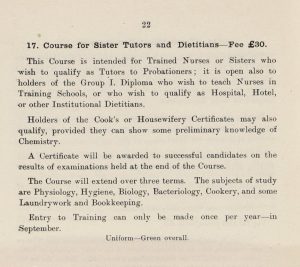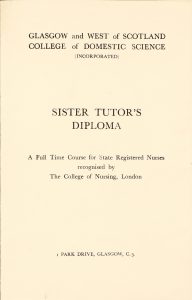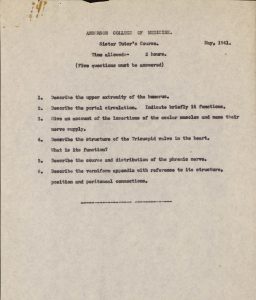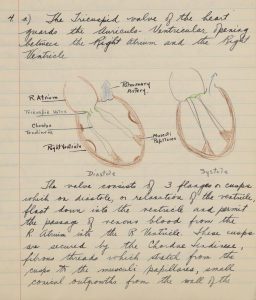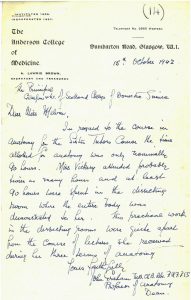A Wellcome Trust Research Resources Project
The School of Health and Life Sciences at Glasgow Caledonian University offers a number of undergraduate and postgraduate courses in nursing. What is perhaps less well known is that its predecessor institution, the Glasgow and West of Scotland College of Domestic Science (GWSCDS), had ventured into nursing-related courses as early as 1925.
The Diploma and certificate course for sister tutors and dietitians was developed in response to a shortage of nurses and dietitians in the workforce. It was open to trained nurses who would gain the qualification to enable them to teach nurses in training schools. It was also open to Group I diploma students (diploma in cookery, laundrywork and housewifery) who could qualify as hospital, hotel or institutional dietitians. Classes started in September and lasted two terms, including the study of physiology, hygiene, biology, bacteriology, cookery, some laundrywork and book-keeping. The cost of the course was £20, increasing to £30 the following year when it was lengthened to three terms. In the first year of the course two students enroled, one wanting to qualify as a sister tutor and one as a dietitian. Margaret Duncan, a registered nurse from the Childrens’ Hospital, Liverpool, was awarded her sister tutor certificate in 1927. The next nurse to qualify as a sister tutor was Harriet K Jamieson in October 1932. She had been enrolled by the Royal Alexandra Infirmary, Paisley. The following year Isabella P Rose, a nurse from the Western Infirmary, Glasgow, enrolled as a sister tutor but then opted to gain the dietetics certificate. While the sister tutor option was struggling to attract students, dietetics was going from strength to strength. Between 1933 and 1939 only one student enrolled as a sister tutor student compared to 104 dietetics students. With such an imbalance, in 1940, the course was split into two, a Post-graduate diploma and certificate for dieticians and a Post-graduate diploma (sister tutors).
This new sister tutors diploma was the first to be offered in Scotland and was now recognised by the College of Nursing, London. The syllabus had been improved and special arrangements made with Professor J Graham of the Anatomy Department, Anderson College of Medicine (which later merged with the University of Glasgow Medical Faculty) to teach anatomy to the level required by the College of Nursing. Phonetics and educational methods were taught by visiting lecturers from the Glasgow Training College and physiology, and chemistry, bacteriology, cookery, dietetics and book-keeping taught by staff of the GWSCDS. The first student to qualify on the new course was Katherine Vickery, in 1941. She was appointed as a sister tutor by the Royal Cancer Hospital, Glasgow, but in September 1942 the General Nursing Council for Scotland wrote to the hospital to say that they were “unable to recognise the qualifications held by Miss Vickery as being sufficient to qualify her to accept entire responsibility for the teaching of lectures on anatomy and physiology”. It had been assumed that as the College of Nursing had recognised the course there was no need to approach any other nursing body for recognition. Dorothy Melvin, College Principal, wrote to the Council to have this rectified but, despite the shortage of qualified sister tutors, the General Nursing Council for Scotland were reluctant to recognise the course. When the Royal College of Nursing was brought in to arbitrate they also criticised the course, which they had approved previously.
- Sister Tutor’s anatomy exam questions, May 1941
- Student’s anatomy exam paper, May 1941
From 1941 the GWSCDS had also offered a 2 year Preparatory course for prospective nurse probationers. This was designed to fill the gap for students leaving school who were still too young to enter hospital as a nursing probationer. The sister tutor course had suffered from lack of recognition from the nursing bodies, but low uptake of the preparatory course indicated that perception of the GWSCDS was also an issue. While it was recognised as a leading institution for domestic sciences, it had no tradition of teaching nurses. Despite its high academic standards, without the perceived nursing credentials, students were not encouraged to enrol on these courses.
The GWSCDS had been willing to bring in additional tutors to cover detailed medical content but a ‘Catch 22’ situation had evolved. The Nursing Council would not endorse the course until they could review a full year of teaching students, but the hospitals would not send students unless the course was recognised by the Council. In April 1943 the GWSCDS decided to discontinue the sister tutors course and focus on courses within their area of expertise of food, nutrition and training of domestic science teachers.
Although the sister tutors option was unsuccessful , the Sister tutors and dieticians course had led the way for the development of dietetics. It is still being taught at Glasgow Caledonian University today. Having evolved into Human nutrition and dietetics undergraduate and postgraduate courses, the University can boast of having the longest running dietetics programme in the UK.
Kirsty Menzies
Wellcome Trust funded Project Archivist
References
Glasgow and West of Scotland College of Domestic Science, Prospectus Session 1925-26 to 1943-44, QC Collection
Governors and appointed committees’ minutes of meetings from 14 Jun 1923-21 Dec 1934, Ref QC/1/2/1/4
Governors and appointed committees’ minutes of meetings from 16 Jan 1935-20 Nov 1940, Ref QC/1/2/1/5
Governors and appointed committees’ minutes of meetings from 12 Dec 1940-6 Dec 1950, Ref QC/1/2/1/6
Sister tutors and dietetics files, 1925-1943, QC Collection
Fees Book : Dietitians, sister tutors and preparatory nurses, 1925-1942, QC Collection
